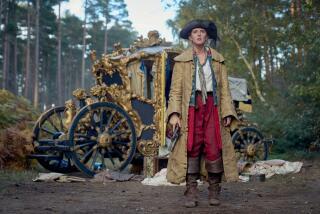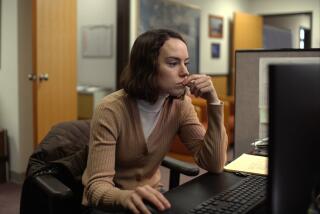For Sally Hawkins, ‘Happy-Go-Lucky’ is not just an act
AS POPPY, the fluttering, free-spirited elementary school teacher at the heart of director Mike Leigh’s new film, “Happy-Go-Lucky,” British actress Sally Hawkins glows like a miniature sun, radiating an infectious sense of joy and a ravenous hunger for life.
But as Hawkins has recently learned, unchecked eagerness can be a dangerous thing. While shooting a romantic comedy over the summer, Hawkins thought she’d have a go at doing her own minor stunts; the result was that she arrived at the recent Toronto International Film Festival with a broken clavicle and her right arm in a sling.
“I was in high heels and a wedding dress, and I was on somebody’s back at the time, and I had to propel myself through the air,” she says with a laugh. “I was a bit Buster Keaton-esque, and slightly enthusiastic.”
There’s nothing slight about the enthusiasm Hawkins brings to her character in “Happy-Go-Lucky,” which opens in theaters on Friday. Poppy approaches each new experience with childlike alertness and an almost pathologically upbeat nature. When she discovers her bicycle has been stolen, she reacts not with shock or anger, but a kind of wistful disappointment. “I didn’t even get a chance to say goodbye,” she sighs.
The loss of her bike brings Poppy into contact with Scott (Eddie Marsan), a driving instructor whose volcanic rages are the flip side of Poppy’s aggressive optimism. The more he seethes, at her and at the world, the more she laughs. Although Poppy sometimes comes off as a blithe spirit, she is no credulous Candide, oblivious to the world’s darker side. Her pointed good-naturedness recalls the watchword for John Cusack’s character in “Say Anything”: “Optimism as a revolutionary act.”
“She definitely loves to tease, and provoke and push,” Hawkins says. “She’s a teacher. She challenges people.”
As is Leigh’s custom, Poppy was built from scratch, created out of conversations with Hawkins over several months. “You talk about people you know, or people that you’ve seen on the street or on the train, and he’s taking notes all the time,” Hawkins says. “You’re pulling together all this information, he’s sort of sucking it out of you, and he then focuses on something that he obviously likes. It’s like going through a filing system in your brain.”
The piecemeal approach carries through into Polly’s wardrobe, an incandescent patchwork of mismatched scraps. One memorable ensemble involves a hot-pink bra, a bright orange thong and a pair of fishnet tights. “Poppy is like a magpie,” Hawkins says. “She collects, and she can’t stop. Through the rehearsal process, we had to go out in character, and I would be hours in one shop. You’d come back with bags of stuff, and then you’d have to take it back to the charity shop. But there were lots of things I used in rehearsal that just continued seamlessly into the film. The denim skirt, that was around early on, and the boots and the tights. There was no stepping into a costume that was already prepared for me, that somebody in another place had set up and thought, ‘Well, this is Poppy.’ ”
Leigh, who cast Hawkins in his previous film, “Vera Drake,” as an upper-class rape victim seeking an illegal abortion, isn’t known for his upbeat fare, and “Happy-Go-Lucky” shows shades of his previous work in Poppy’s confrontations with Scott and in her encounter with a homeless man (Stanley Townsend) whose deranged ravings climax with a plaintive, “You know? You know?” (As it turns out, she does.) But the vibrant colors of Dick Pope’s cinematography make a tacit promise that Poppy will emerge unscathed.
Although Leigh often depicts a gritty realism, characters like Scott and Poppy have a heightened, almost hyper-real quality. They are like walking character traits reverse-engineered to fit the real world. “He is true to life, but what I love about Mike is his theatricality,” she says. “He’s almost Dickensian. His characters are drawn with incredibly strong lines. But within that, they’re very complex and multifaceted, and you can focus in and in and in on the detail. That’s why you have six months to explore and layer it up and make it as rich as you can.”
Poppy’s preternatural good humor comes, Hawkins says, with “an edge,” which shows up when she suspects one of her students is being physically abused. “The way I can describe it with Poppy is like a bubble of laughter caught in the throat,” she says, her voice shifting into Poppy’s anxious croak. “I knew I had to have that in every scene. Even if it wasn’t laughter, there’s a bubble of something in her that’s waiting to explode.”
In “Happy-Go-Lucky’s” opening scene, Poppy browses a bookstore, pointedly choosing the children’s book section over a copy of “The Road to Reality.” (“Don’t want to be going there,” she quips.) Hawkins’ parents, Colin and Jacqui, write and illustrate children’s books, and when she was young, they were art teachers, both details that, in one way or another, found their way into Poppy’s character. Hawkins certainly seems to have no trouble accessing the childlike part of herself. “It was a real gift to tap into that,” she says. “People can access that innocence or curiosity about life, and that colorful, magical world. I had that growing up, and it was lovely.”
Hawkins still lives in that world, at least when she’s working. “I’ll never really get tired of that. It is play, when it’s right and when you’re working with people that give you that opportunity and that freedom. I’ll never get tired of that.”
More to Read
The biggest entertainment stories
Get our big stories about Hollywood, film, television, music, arts, culture and more right in your inbox as soon as they publish.
You may occasionally receive promotional content from the Los Angeles Times.






